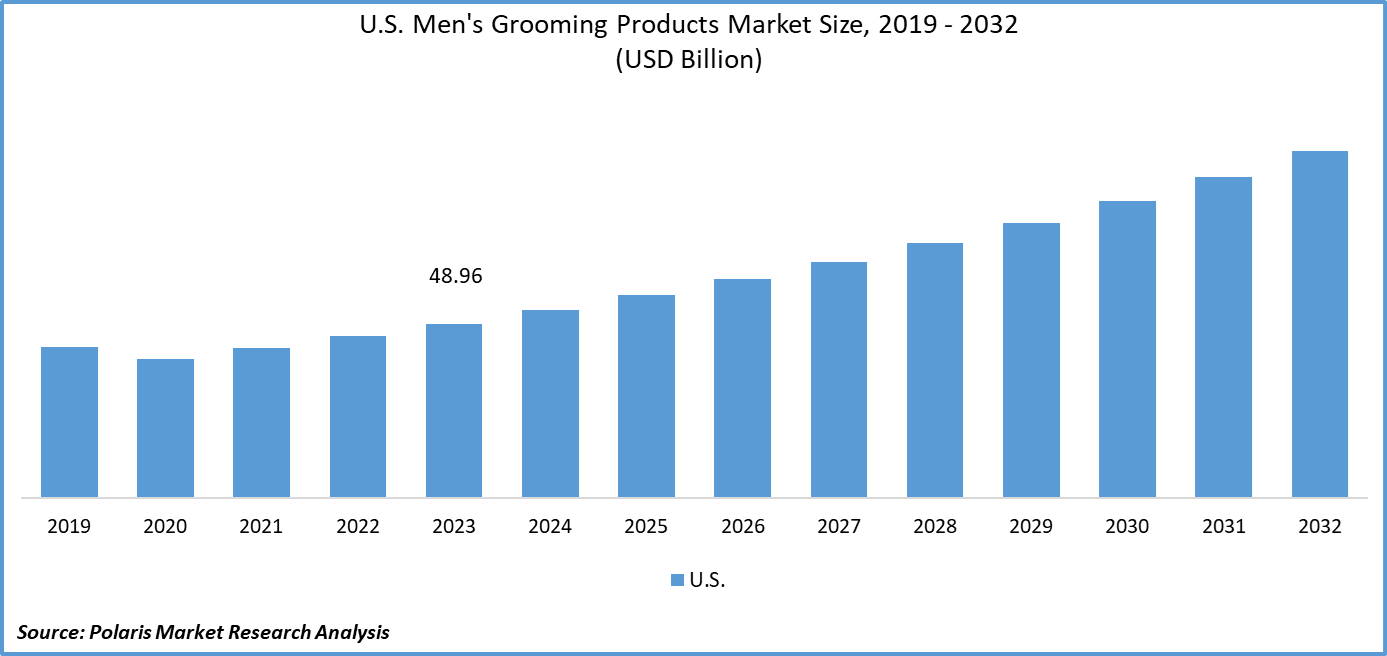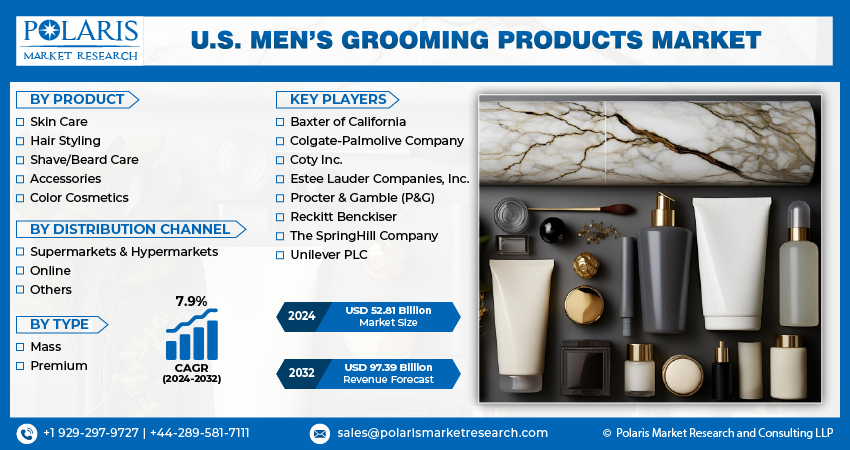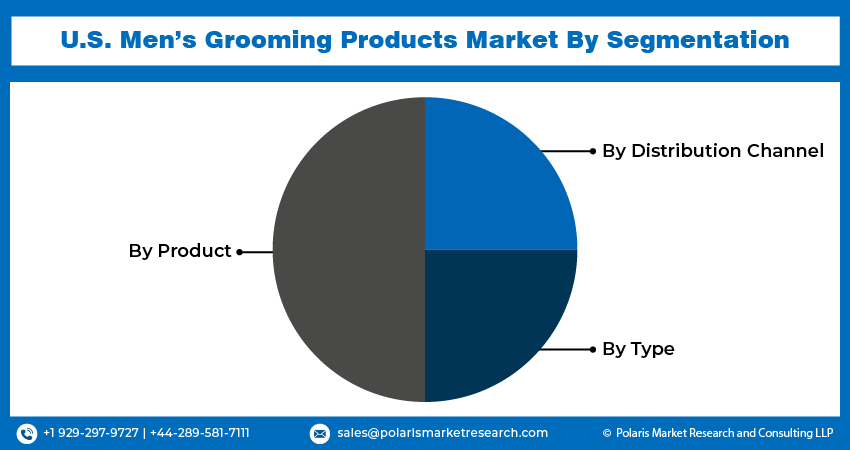
U.S. Men’s Grooming Products Market Share, Size, Trends, Industry Analysis Report
By Product (Skin Care, Hair Styling, Shave/Beard Care, Accessories, And Color Cosmetics); By Distribution Channel; By Type; Segment Forecast, 2024- 2032
- Published Date:Apr-2024
- Pages: 119
- Format: PDF
- Report ID: PM4879
- Base Year: 2023
- Historical Data: 2019-2022
Report Outlook
The U.S. men’s grooming products Market size was valued at USD 48.96 billion in 2023. The market is anticipated to grow from USD 52.81 billion in 2024 to USD 97.39 billion by 2032, exhibiting a CAGR of 7.9% during the forecast period
Industry Trend
The U.S. men's grooming products market is experiencing a notable surge in attention and investment, propelled. The shifting cultural norms surrounding manhood have evolved to embrace self-care and grooming as essential components of personal wellness. This cultural shift, coupled with evolving consumer preferences, has led to a broadening of the market's scope, encompassing a diverse array of personal care items specifically tailored for men. This includes skincare products addressing concerns such as hydration, anti-aging, and acne prevention, as well as haircare solutions targeting styling, hair loss, and scalp health. Shaving products, encompassing razors, shaving creams, and aftershaves, remain a cornerstone of the market, catering to men's grooming rituals. Fragrances, ranging from traditional colognes to niche perfumes, further contribute to the market's breadth and appeal.

To Understand More About this Research: Request a Free Sample Report
As more men incorporate grooming routines into their daily regimens, the market's potential for growth continues to expand. Established players and emerging brands alike are seizing opportunities to meet this rising demand and cater to diverse consumer needs and preferences.
Moreover, the growing trend of male self-care underscores the market's resilience and potential for robust growth. Men are increasingly prioritizing personal grooming and wellness, seeking products that deliver tangible benefits and enhance their overall appearance and confidence. In response, brands are innovating with new product formulations, packaging designs, and marketing strategies to capture consumer attention and differentiate themselves in an increasingly competitive landscape. This focus on innovation and differentiation not only drives market expansion but also fosters a culture of continuous improvement and creativity within the industry. As a result, significant growth is expected in the U.S. men’s grooming products market share during the forecast period.
- For instance, in February 2024, LeBron James, alongside Maverick Carter's The SpringHill Company, is making waves in the beauty industry with the introduction of a comprehensive men's grooming line. Teaming up with Parlux, the production company plans to roll out seven products designed to meet the diverse needs of skin, hair, and beard care.
The proliferation of e-commerce platforms has democratized access to men's grooming products, allowing consumers to explore and purchase items conveniently from the comfort of their homes. Social media and digital marketing channels play a pivotal role in shaping consumer perceptions and driving purchasing decisions, further amplifying the market's momentum. Hence significant growth is expected in the U.S. men’s grooming products market share during the forecast period.
Key Takeaway
- By product category, the skincare segment accounted for the largest market share in 2023.
- By distribution channel category, the supermarkets & hypermarkets segment is projected to grow at a high CAGR during the projected period.
What are the market drivers driving the demand for the U.S. men’s grooming products market?
Increasing consumer preferences have been projected to spur product demand.
Men's increased consciousness of their appearance and overall well-being is a significant trend shaping the men's grooming products market. Traditionally, societal norms placed less emphasis on men's grooming compared to women's, but in recent years, there has been a notable shift. Men are now paying closer attention to their grooming routines as they recognize the impact it they can have on their self-confidence, professional image, and overall sense of well-being.
This heightened awareness has led men to seek out products that cater specifically to their skincare, haircare, and grooming needs. Men have diverse concerns ranging from acne and oily skin to hair loss and styling preferences. They are looking for solutions that address these concerns effectively and efficiently. As a result, there has been a surge in demand for specialized men's grooming products that are formulated to meet the unique needs of male skin and hair.
Skincare products tailored for men often focus on addressing common issues such as acne, inflammation, and signs of aging. They may include ingredients like salicylic acid, retinol, and hyaluronic acid to target specific concerns while maintaining skin health. Similarly, men's haircare products may offer solutions for scalp health, hair loss prevention, and styling versatility. From shampoos and conditioners to styling gels and pomades, there's a wide range of products designed to cater to men's diverse haircare needs. As a result, U.S. men’s grooming products market share is expected to grow during the forecast period.

Which factor is restraining the demand for U.S. men’s grooming products?
The pricing of men's grooming products is expected to hinder the growth of the market.
The pricing of men's grooming products can also be a restraining factor. Some higher-end grooming products can be relatively expensive, which may deter price-sensitive consumers from purchasing them, especially during times of economic hardship. During economic downturns, consumers may prioritize spending on essential items rather than discretionary products like grooming products. As a result, they may cut back on non-essential purchases, including skincare, haircare, and grooming items, which could lead to a decline in demand for men's grooming products.
Moreover, shifts in consumer preferences and lifestyle changes can impact demand for men's grooming products. For example, a cultural shift away from the emphasis on appearance or a preference for more natural or minimalist grooming routines could decrease demand for certain grooming products. Hence the US men's grooming products market is expected to hinder the growth.
Report Segmentation
The market is primarily segmented based on product, distribution channel, type.
|
By Product |
By Distribution Channel |
By Type |
|
|
|
To Understand the Scope of this Report: Speak to Analyst
Category Wise Insights
By Product Insights
Based on product analysis, the market is segmented into skin care, hair styling, shave/beard care, accessories, and color cosmetics. The skin care segment held the largest market share in 2023. However, in the past few years, there has been a shift in societal norms regarding masculinity. Men are increasingly embracing self-care practices, including skincare, as part of their grooming routine. This cultural shift has led to a growing demand for skincare products tailored specifically for men.
With the rise of social media and digital marketing, there has been greater awareness and education about skincare routines and products among men. Beauty influencers, male celebrities, and skincare brands have played a significant role in promoting the importance of skincare for men. Skincare brands have been actively developing and launching products targeting male consumers. These products often come with formulations and packaging designed to appeal to men. From cleansers to moisturizers to anti-aging creams, there's a wide array of skin care products available for men to choose from.
By Distribution Channel Insights
Based on distribution channel analysis, the market has been segmented on the basis of supermarkets & hypermarkets, online, and others. The supermarkets & hypermarkets segment expected to be the fastest growing CAGR during the forecast period. Supermarkets and hypermarkets offer convenience to consumers as they are easily accessible and often located in residential areas. Men who are looking for grooming products can conveniently purchase them while doing their routine grocery shopping. Supermarkets and hypermarkets typically have a wide assortment of products, including men's grooming items. This variety allows consumers to choose from a range of brands, price points, and product types, catering to different preferences and needs.

Competitive Landscape
The competitive landscape of the U.S. men's grooming products market is characterized by a diverse array of players ranging from multinational corporations to niche boutique brands. The companies leverage their strong brand presence, widespread distribution networks, and extensive R&D capabilities to maintain market leadership. Additionally, direct-to-consumer brands have disrupted the market with innovative subscription models and digital marketing strategies, appealing to younger consumers seeking convenience and value. Furthermore, the market features a vibrant ecosystem of indie brands and startups capitalizing on evolving consumer preferences for natural, organic, and cruelty-free products. With consumers increasingly prioritizing personal care and grooming routines, competition in the U.S. men's grooming products market remains fierce, driving innovation and diversity across the sector.
Some of the major players operating in the global market include.
- Baxter of California
- Colgate-Palmolive Company
- Coty Inc.
- Estee Lauder Companies, Inc.
- Procter & Gamble (P&G)
- Reckitt Benckiser
- The SpringHill Company
- Unilever PLC
Recent Developments
- In June 2023, Procter & Gamble's renowned Old Spice brand stole the spotlight at the Super Bowl LVII festivities with the unveiling of its captivating "Smelf-Confidence" campaign.
Report Coverage
The U.S. men’s grooming products market report emphasizes on key regions across the globe to provide better understanding of the product to the users. Also, the report provides market insights into recent developments, trends and analyzes the technologies that are gaining traction around the globe. Furthermore, the report covers in-depth qualitative analysis pertaining to various paradigm shifts associated with the transformation of these solutions.
The report provides detailed analysis of the market while focusing on various key aspects such as competitive analysis, product, distribution channel, type, and their futuristic growth opportunities.
U.S. Men’s Grooming Products Market Report Scope
|
Report Attributes |
Details |
|
Market size value in 2024 |
USD 52.81 Billion |
|
Revenue forecast in 2032 |
USD 97.39 billion |
|
CAGR |
7.9% from 2024 – 2032 |
|
Base year |
2023 |
|
Historical data |
2019 – 2022 |
|
Forecast period |
2024 – 2032 |
|
Quantitative units |
Revenue in USD billion and CAGR from 2024 to 2032 |
|
Segments covered |
By Product, By Distribution Channel, By Type |
|
Customization |
Report customization as per your requirements with respect to countries, region and segmentation. |
FAQ's
key companies in U.S. Men’s Grooming Products Market are California, Colgate-Palmolive Company, Coty Inc., Estee Lauder Companies, Inc
The U.S. men’s grooming products Market exhibiting a CAGR of 7.9% during the forecast period
The U.S. Men’s Grooming Products Market report covering key segments are product, distribution channel, type.
key driving factors in U.S. Men’s Grooming Products Market are rising Disposable Income
The global U.S. Men’s Grooming Products Market size is expected to reach USD 97.39 billion by 2032
